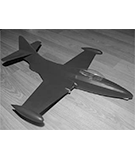 Random image Random image |
 |

GRUMMAN F9F-5 PANTHER
nitrocharged
|
 |
|
 |
 |
FLATCAT
| FLATCAT |
| Description: |
Last month covered the basic principles of boost-glider design. The FlatCat applies them to a simple beginner's BG. Behind it is three years of development and flight testing. FlatCat, by Harry Stine.
Last month we talked about the basic principles of boost-glider design. Lest anybody get frightened over the possible complexities involved in BG work, and in order to develop greater interest on the part of both rocket and aeromodelers in this fascinating sector of model rocketry that overlaps more than a little into model aeronautics, one should follow up the 'why' with the 'how,' which is just what we're going to do.
Most of the seven BG kits now on the market as of this writing are reasonably easy to assemble and will perform quite well Some are easier to modify for com-petition than others, but all must be modi-fied to conform with the NAR rule re-quiring 36 sq. in. of streamer or parachute area per ounce of jettisoned weight. Most of the kit jobs are too small, giving them a strong tendency to go bye-bye with high-powered engines. And they aren't normally amenable to controlled experimental modi-fications.
The late Charles Duelfer of Stamford, Conn. suggested to me in 1964 that a simple beginner's BG was needed. In com-mon with many other areas of technology,
it often requires a great deal of understand-ing in order to come up with something that is really simple, and simplicity often belies the fact that a lot of head scratching lies behind the whole thing. It took three years to come up with the 'FlatCat,' and I am certain that FlatCat is not the final word.
FlatCat was specifically designed as a BG that could be built easily by beginners while at the same time being suitable for improved competition performance with minor modifications. It is presumed that the builder has constructed at least one streamer-recovery model rocket, that he is capable of making a good glue joint, and that he has enough visual perception and patience to get things more or less lined up. No matter how simple a BG design is, it still takes a wee bit of care to put one together, but the same holds true for a simple chuck glider. Having obtained the parts detailed in the bill of materials, you are ready to start construction, which, if you follow these steps, is simple.
1) Cut wings from 3/32 sheet balsa. Bevel root chord edges with sandpaper and glue wings together with each tip elevated 1-3/4. Use double-glue joint and let dry thoroughly.
2) Cut stab and rudders from 1/16 sheet balsa. Mark center line on both sides of stab. Glue rudders on top of stab tips. Align carefully. Let dry thoroughly.
3) Mark two lines down opposite sides of engine tube. Attach engine holder to top of tube. Install shock cord and glue screw eye into base of nose cone. Install nose cone and streamer in tube.
4) Make pylon from 1/4 x 1-1/2 x 4 in balsa. Cut front end to 45-degrees and back end to 30-degrees as shown in plans. Round front end and taper back end to stream-lined section (optional). Glue pylon to tube on opposite side from engine holder. Align carefully. Glue launch lug to left side of pylon-tube joint. Let dry thoroughly.
5) Mark center line down top and bot-tom of fuselage. Measure and mark loca-tion of wing atop fuselage and stab below fuselage. Taper top of fuselage from wing trailing edge aft as shown. Sand tail of fuselage to point as shown on top view.
Plans Includes article. |
| Keywords: |
flat cat jetex 50 harry stine |
| Date: |
19.02.2021 23:37 |
| Hits: |
2924 |
| Downloads: |
8 |
| Rating: |
0.00 (0 Vote(s)) |
| File size: |
33.8 KB |
| Added by: |
nitrocharged |
|
|
 |
